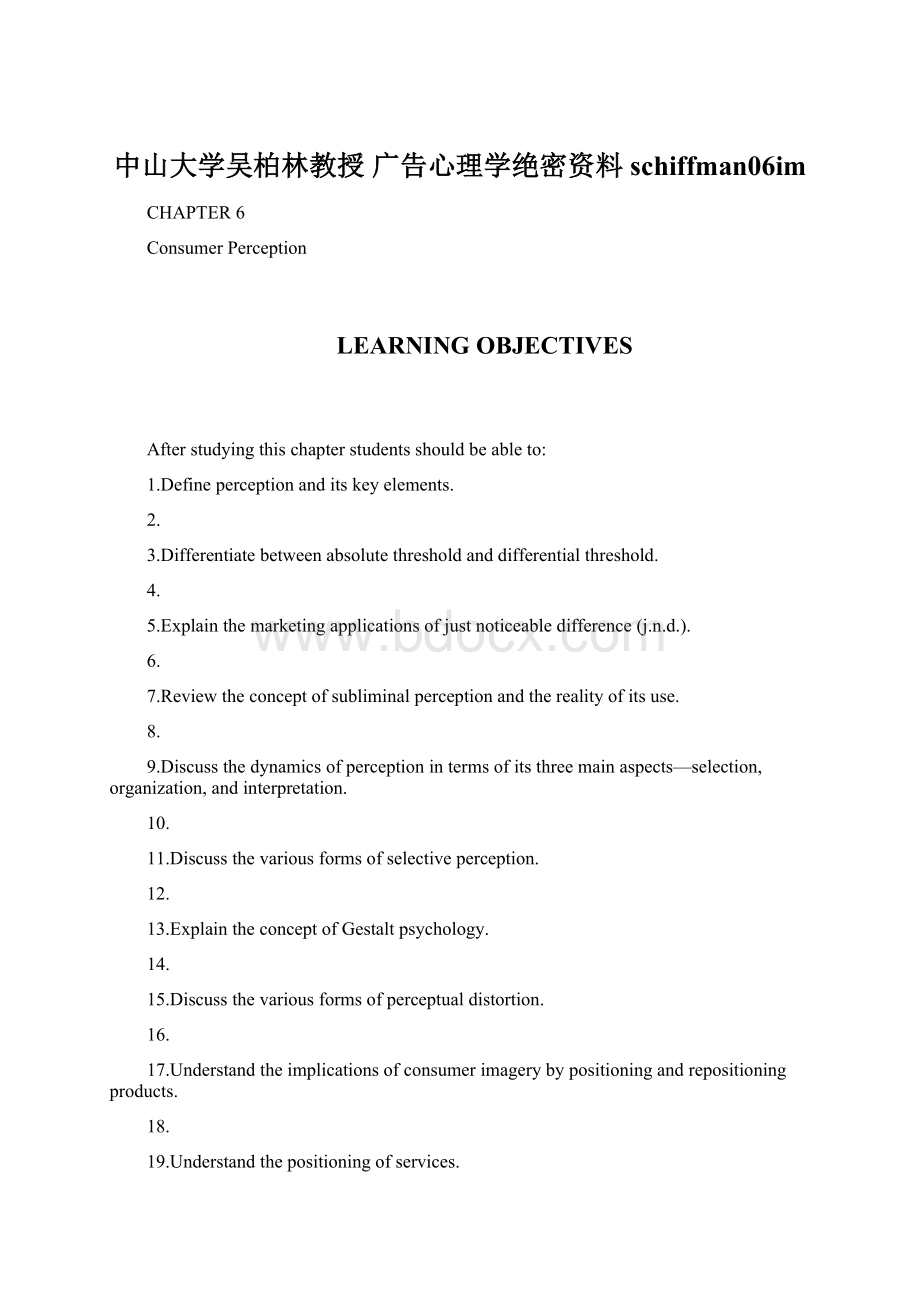中山大学吴柏林教授 广告心理学绝密资料schiffman06im.docx
《中山大学吴柏林教授 广告心理学绝密资料schiffman06im.docx》由会员分享,可在线阅读,更多相关《中山大学吴柏林教授 广告心理学绝密资料schiffman06im.docx(48页珍藏版)》请在冰豆网上搜索。

中山大学吴柏林教授广告心理学绝密资料schiffman06im
CHAPTER6
ConsumerPerception
LEARNINGOBJECTIVES
Afterstudyingthischapterstudentsshouldbeableto:
1.Defineperceptionanditskeyelements.
2.
3.Differentiatebetweenabsolutethresholdanddifferentialthreshold.
4.
5.Explainthemarketingapplicationsofjustnoticeabledifference(j.n.d.).
6.
7.Reviewtheconceptofsubliminalperceptionandtherealityofitsuse.
8.
9.Discussthedynamicsofperceptionintermsofitsthreemainaspects—selection,organization,andinterpretation.
10.
11.Discussthevariousformsofselectiveperception.
12.
13.ExplaintheconceptofGestaltpsychology.
14.
15.Discussthevariousformsofperceptualdistortion.
16.
17.Understandtheimplicationsofconsumerimagerybypositioningandrepositioningproducts.
18.
19.Understandthepositioningofservices.
20.
21.Explaintheimpactofpriceonconsumerperceptionofproducts,service,andquality.
22.
23.Discussthetermsretailstoreimageandmanufacturer’simage.
24.
25.Describeconsumers’perceptionofriskandkeyriskreductionstrategies.
26.
SUMMARY
Perceptionistheprocessbywhichindividualsselect,organize,andinterpretstimuliintoameaningfulandcoherentpictureoftheworld.Perceptionhasstrategyimplicationsformarketersbecauseconsumersmakedecisionsbasedonwhattheyperceiveratherthanonthebasisofobjectivereality.
Thelowestlevelatwhichanindividualcanperceiveaspecificstimulusisthatperson’sabsolutethreshold.Theminimaldifferencethatcanbeperceivedbetweentwostimuliiscalledthedifferentialthresholdorjustnoticeabledifference(j.n.d.).Moststimuliareperceivedbyconsumersabovetheleveloftheirconsciousawareness;however,weakstimulicanbeperceivedbelowthelevelofconsciousawareness(i.e.,subliminally).Researchrefutesthenotionthatsubliminalstimuliinfluenceconsumer-buyingdecisions.
Consumers’selectionofstimulifromtheenvironmentisbasedontheinteractionoftheirexpectationsandmotiveswiththestimulusitself.Theprinciplesofselectiveperceptionincludethefollowingconcepts:
selectiveexposure,selectiveattention,perceptualdefense,andperceptualblocking.Peopleusuallyperceivethingstheyneedorwant,andblocktheperceptionofunnecessary,unfavorable,orpainfulstimuli.
ConsumersorganizetheirperceptionsintounifiedwholesaccordingtotheprinciplesofGestaltpsychology:
figureandground,grouping,andclosure.Theinterpretationofstimuliishighlysubjectiveandisbasedonwhattheconsumerexpectstoseeinlightofpreviousexperience,onthenumberofplausibleexplanationsheorshecanenvision,onmotivesandinterestsatthetimeofperception,andontheclarityofthestimulusitself.Influencesthattendtodistortobjectiveinterpretationincludephysicalappearances,stereotypes,haloeffects,irrelevantcues,firstimpressions,andthetendencytojumptoconclusions.
Justasindividualshaveperceivedimagesofthemselves,theyalsohaveperceivedimagesofproductsandbrands.Theperceivedimageofaproductorservice(howitispositioned)isprobablymoreimportanttoitsultimatesuccessthanareitsactualphysicalcharacteristics.Productsandservicesthatareperceiveddistinctlyandfavorablyhaveamuchbetterchanceofbeingpurchasedthanproductsorserviceswithunclearorunfavorableimages.
Comparedwithmanufacturingfirms,servicemarketersfaceseveraluniqueproblemsinpositioningandpromotingtheirofferingsbecauseservicesareintangible,variable,perishable,andaresimultaneouslyproducedandconsumed.Regardlessofhowwellpositionedaproductorserviceappearstobe,themarketermaybeforcedtorepositionitinresponsetomarketevents,suchasnewcompetitorstrategiesorchangingconsumerpreferences.
Consumersoftenjudgethequalityofaproductorserviceonthebasisofavarietyofinformationalcues;someareintrinsictotheproduct(suchascolor,size,flavor,andaroma),whereasothersareextrinsic(e.g.,price,storeimage,brandimage,andserviceenvironment).Intheabsenceofdirectexperienceorotherinformation,consumersoftenrelyonpriceasanindicatorofquality.Howaconsumerperceivesaprice—ashigh,low,orfair—hasastronginfluenceonpurchaseintentionsandsatisfactions.Consumersoftenrelyonbothinternalandexternalreferencepriceswhenassessingthefairnessofaprice.
Consumerimageryalsoincludesperceivedimagesofretailstoresthatinfluencetheperceivedqualityofproductstheycarry,aswellasdecisionsastowheretoshop.Manufacturerswhoenjoyafavorableimagegenerallyfindtheirnewproductsareacceptedmorereadilythanthoseofmanufacturerswithlessfavorableimages.
Consumersoftenperceiveriskinmakingproductselectionsbecauseofuncertaintyastotheconsequencesoftheirproductdecisions.Themostfrequenttypesofriskthatconsumersperceivearefunctionalrisk,physicalrisk,financialrisk,socialrisk,psychologicalrisk,andtimerisk.Consumerstrategiesforreducingperceivedriskincludeincreasedinformationsearch,brandloyalty,buyingawell-knownbrand,buyingfromareputableretailer,buyingthemostexpensivebrand,andseekingreassuranceintheformofmoney-backguarantees,warranties,andprepurchasetrial.Theconceptofperceivedriskhasimportantimplicationsformarketers,whocanfacilitatetheacceptanceofnewproductsbyincorporatingrisk-reductionstrategiesintheirnew-productpromotionalcampaigns.
CHAPTEROUTLINE
INTRODUCTION
1.Individualsactandreactonthebasisoftheirperceptions,notonthebasisofobjectivereality.
2.
a)Therefore,consumers’perceptionsaremoreimportanttoamarketerthantheirknowledgeofobjectivereality,becausepeoplemakedecisionsbasedontheirperceptions.
b)
3.Inthischapterweexaminethepsychologicalandphysiologicalbasesofhumanperceptionandtheprinciplesthatcontrolthatperceptionandtheinterpretationofwhatwesee.
4.
a)Understandingthisinformationenablesmarketerstodevelopmoreeffectiveadvertisements.
b)
ELEMENTSOFPERCEPTION
1.Perceptionistheprocessbywhichanindividualselects,organizes,andinterpretsstimuliintoameaningfulandcoherentpictureoftheworld.
2.
*****UseKeyTermperceptionHere;UseLearningObjective#1Here*****
Sensation
1.Sensationistheimmediateanddirectresponseofthesensoryorganstostimuli(anadvertisement,apackage,andabrandname).
2.
3.Astimulusisanyunitofinputtoanyofthesenses.
4.
5.Sensoryreceptorsarethehumanorgans(i.e.,theeyes,ears,nose,mouth,andskin)thatreceivesensoryinputs,sight,sound,smell,taste,ortouch.
6.
7.Humansensitivityreferstotheexperienceofsensation.
8.
a)Sensitivitytostimulivarieswiththequalityofanindividual’ssensoryreceptorsandtheamountorintensityofthestimulitowhichhe/sheisexposed.
b)
c)Sensationitselfdependsonenergychange,thedifferenceofinput.
d)
e)Thus,aconstantenvironment,whetherverybusyandnoisyorrelativelyquiet,wouldprovidelittlesensationbecauseofthelackofchange,theconsistentlevelofstimulation.
f)
9.Assensoryinputdecreases,theabilitytodetectchangesincreases.
10.
a)Thisabilityofthehumanorganismtoaccommodateitselftovaryinglevelsofsensitivityasexternalconditionsvarynotonlyprotectsusfromdamaging,disruptive,orirrelevantbombardmentwhentheinputlevelishighbuthasimportantimplicationsformarketers.
b)
*****UseKeyTermssensationandsensoryreceptorsHere;UseLearningObjective#1
Here*****
TheAbsoluteThreshold
1.Thelowestlevelatwhichanindividualcanexperienceasensationiscalledtheabsolutethreshold.
2.
a)Thepointatwhichapersoncandetectthedifferencebetween“something”and“nothing”isthatperson’sabsolutethresholdforthestimulus.
b)
c)Forexample,thedistanceatwhichadrivercannoteaspecificbillboardonahighwayisthatindividual’sabsolutethreshold.
d)
e)Underconditionsofconstantstimulation,suchasdrivingthrougha“corridor”ofbillboards,theabsolutethresholdincreases(thatis,thesensestendtobecomeincreasinglydulled).
f)
3.Adaptationrefersspecificallyto“gettingusedto”certainsensations,becomingaccustomedtoacertainlevelofstimulation.
4.
a)Sensoryadaptationisaproblemthatcausesmanyadvertiserstochangetheiradvertisingcampaignsregularly.
b)
*****UseKeyTermsabsolutethresholdandsensoryadaptationHere;UseDiscussion
Question#1Here*****
5.Marketerstrytoincreasesensoryinputinordertocutthroughthedailyclutterconsumersexperienceintheconsumptionofadvertising.
6.
a)Someincreasesensoryinputinanefforttocutthroughtheadvertising“clutter.”
b)
7.Otheradvertiserstrytoattractattentionbydecreasingsensoryinput.
8.
a)Someadvertisersusesilence(theabsenceofmusicorotheraudioeffects)togenerateattention.
b)
c)Somemarketersseekunusualmediainwhichtoplacetheiradvertisementsinanefforttogainattention.
d)
e)Someusescentresearcherstoenhancetheirproductswithauniquesmell.
f)
9.Packagedesignerstrytodetermineconsumers’absolutethresholdstomakesurethattheirnewproductdesignswillstandoutfromcompetitors’packagesonretailers’shelves.
10.
*****UseLearningObjective#1and#2Here;UseDiscussionQuestion#1and#2Here;Use
Figure6-1Here*****
TheDifferentialThreshold
1.Theminimaldifferencethatcanbedetectedbetweentwostimuliiscalledthedifferencethresholdorthej.n.d.(justnoticeabledifference).
2.
3.A19thcenturyGermanscientistnamedErnst